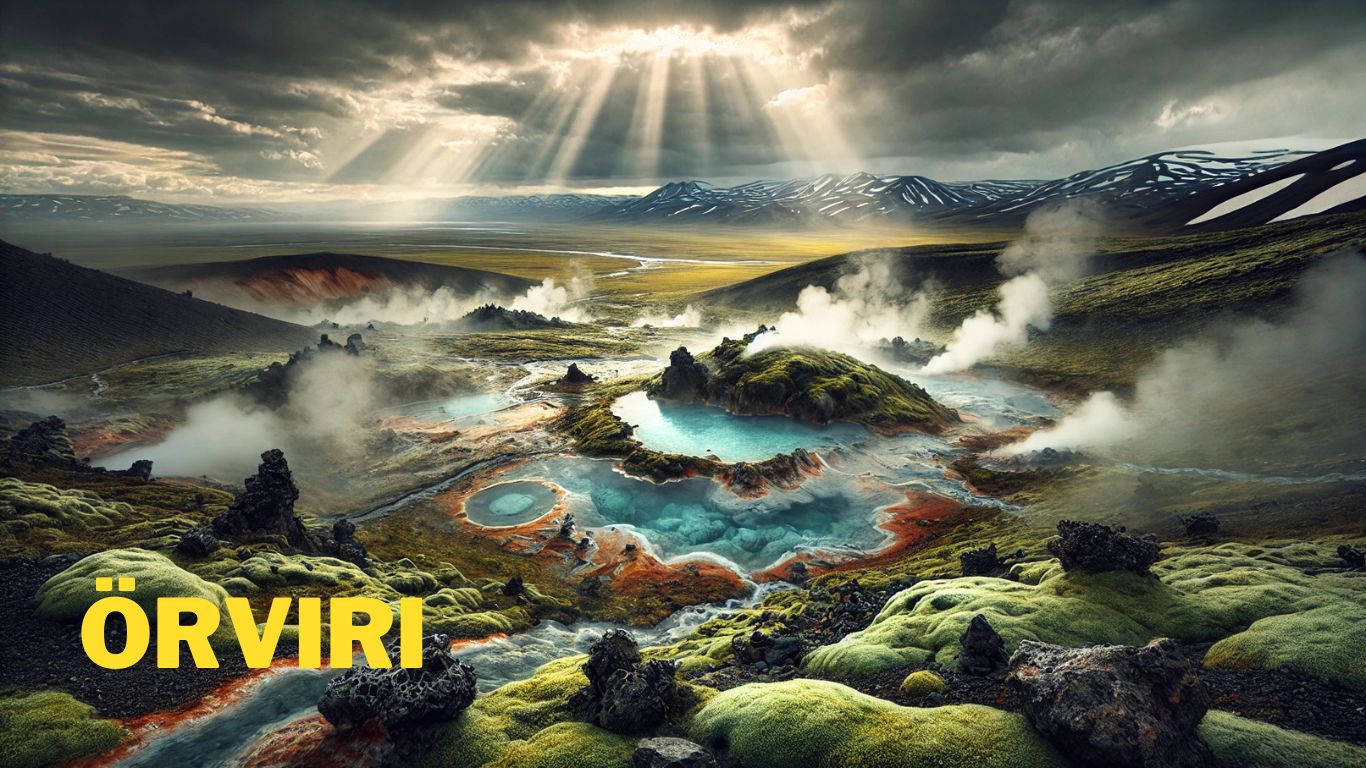Iceland, known for its stunning landscapes and natural wonders, holds within its terrain a collection of rare and extraordinary phenomena that captivate locals and tourists alike. Among these is the unique occurrence known as örviri. This lesser-known phenomenon holds cultural and scientific significance, captivating researchers and nature enthusiasts who seek to understand its mystery. From its formation to the roles it plays in local ecology and culture, örviri is not merely a natural occurrence but an integral part of Iceland’s identity.
What is örviri?
The term örviri is Icelandic, representing a specific natural phenomenon unique to the region. This event, seen in specific conditions, features environmental and ecological changes that set it apart from any other naturally occurring event worldwide. Generally witnessed in isolated areas, örviri’s rarity makes it an alluring topic for scientists and locals who wish to learn more about the interdependent systems within Iceland’s ecosystem. Despite its elusiveness, those fortunate enough to witness örviri describe it as awe-inspiring, contributing further to its mystique.
The Formation of örviri: Geological and Environmental Factors
To understand örviri, examining its geological origins and environmental conditions proves essential. Iceland’s geological activity, shaped by volcanic landscapes, glacial rivers, and geothermal areas, provides the backdrop that allows örviri to form. It is believed that specific shifts in the earth’s crust, often alongside extreme weather patterns, play a pivotal role in its appearance. The presence of rich mineral deposits, along with seasonal temperature fluctuations, creates an environment where örviri can arise. It is a phenomenon that might only appear under rare conditions where temperature, water flow, and mineral exposure align, giving the world a glimpse of this natural marvel.
Scientific Interest in örviri: A Focus on Rare Icelandic Occurrences
In scientific communities, örviri has spurred a surge of interest as researchers work to understand its unique characteristics. Iceland’s active geothermal areas and volcanic soil play a considerable role in enabling this phenomenon, yet the precise triggers behind örviri remain partially obscured. Current studies focus on analyzing soil samples, mineral content, and temperature data, as these factors seem closely linked to örviri’s manifestation. The relationship between Iceland’s volcanic activity and örviri’s formation has led scientists to hypothesize that underground heat sources may affect the mineral reactions required for örviri to form.
The Cultural Importance in Icelandic Traditions
In Icelandic culture, örviri is more than a geological curiosity; it is intertwined with folklore and ancient stories passed down through generations. Stories surrounding örviri often speak of resilience, unity, and a reverence for nature. It is seen as a reminder of Iceland’s natural beauty and the power that lies within the earth. Some communities even view örviri as a symbol of good fortune, believing that those who witness it are blessed with luck. This cultural reverence has kept örviri in the Icelandic consciousness, highlighting the importance of natural occurrences in Icelandic heritage and daily life.
Its Ecological Significance
Ecologically, örviri plays a vital role within its immediate environment. Its appearance brings subtle but important changes to the local ecosystem. For instance, unique mineral formations that result from örviri contribute nutrients to the soil, benefitting plant growth and providing sustenance for certain animal species. These mineral-rich soils support a range of plant life, from hardy mosses to specialized grasses that thrive under Iceland’s often challenging conditions. Because örviri only occurs sporadically, its ecological contributions are temporary, yet they offer a crucial boost that supports the resilience of Iceland’s flora and fauna.
How Iceland’s Climate Influences örviri
Iceland’s climate, defined by extreme weather patterns, contributes directly to the rare appearance of örviri. Factors such as heavy rainfall, seasonal temperature shifts, and prolonged daylight during the summer create the dynamic conditions necessary for örviri’s occurrence. The continuous flow of water, combined with Iceland’s volcanic terrain, establishes a unique interaction between heat and minerals. Iceland’s rugged landscape, shaped by glaciers and volcanic eruptions, further amplifies this phenomenon by creating geological structures that capture water, allowing for mineral deposits to settle and interact in ways that bring örviri to life.
Seasonal Variations and Their Role in örviri’s Appearance
It has been observed that örviri is most likely to appear during transitional seasons, such as late spring and early autumn, when environmental conditions are in flux. During these times, Iceland experiences significant changes in temperature and daylight hours, impacting water levels in rivers and streams and causing shifts in underground mineral concentrations. The interaction of cold water with warm geothermal sources further contributes to the delicate balance required for örviri to emerge. This seasonal influence not only adds to örviri’s rarity but also enhances its appeal as a fleeting spectacle of Icelandic nature.
Is örviri at Risk Due to Climate Change?
In recent years, concerns have emerged regarding climate change and its impact on Iceland’s natural wonders, including örviri. Rising temperatures, altered rainfall patterns, and changes in seasonal cycles may affect the delicate conditions required for örviri to appear. Some scientists fear that as Iceland’s climate warms, the shifts in soil composition and water temperature could reduce örviri’s frequency. Conservationists emphasize the importance of monitoring these changes, as preserving Iceland’s unique phenomena not only maintains biodiversity but also retains the cultural and ecological richness associated with events like örviri.
Preserving örviri: A Priority for Iceland’s Natural Heritage
To protect örviri and similar natural phenomena, Iceland has implemented conservation strategies aimed at preserving its unique environment. These efforts include limiting human activity near sensitive geothermal and mineral-rich areas and promoting eco-friendly tourism practices. Iceland’s government, alongside local environmental organizations, has also increased efforts to educate the public about örviri and other rare occurrences to cultivate a greater sense of respect for the land. Iceland’s approach demonstrates that environmental preservation when balanced with responsible tourism, can protect natural wonders for future generations.
Experiencing örviri: A Guide for Tourists
For tourists hoping to witness örviri firsthand, understanding the best times and places to visit can improve the chances of experiencing this rare sight. Although unpredictable, örviri is more commonly reported in remote areas away from major tourist sites, making guided tours an ideal option for visitors unfamiliar with Iceland’s terrain. Joining a local guide not only increases the likelihood of encountering örviri but also provides valuable insights into its formation and significance. Additionally, respecting Iceland’s environmental guidelines ensures that travelers contribute positively to the preservation of the region’s natural beauty.
What to Expect When Witnessing örviri
Should you be fortunate enough to witness örviri, expect a unique experience, unlike any other natural phenomenon. Described as both captivating and humbling, örviri may appear as a vibrant display of colors and textures within the land or water, drawing attention to the intricate relationships within Iceland’s geology. This sight often leaves an unforgettable impression, encouraging viewers to reflect on the complexities of nature. For photographers and nature enthusiasts, örviri provides a rare opportunity to capture the essence of Iceland’s wild landscapes, a memory that many cherish long after returning home.
örviri and Iceland’s Tourism Industry
While örviri remains a relatively hidden gem, Iceland’s tourism industry has begun to recognize its appeal among visitors interested in authentic natural experiences. Promotional efforts focus on örviri’s exclusivity and the role it plays in Iceland’s ecosystem. Unlike more prominent attractions like the Northern Lights or geothermal spas, örviri’s rarity appeals to those seeking an off-the-beaten-path adventure. By showcasing örviri alongside Iceland’s other natural phenomena, the tourism industry not only supports local economies but also promotes environmental awareness among visitors.
Studying örviri: Ongoing Research and Future Discoveries
The study of örviri is far from complete, with researchers actively seeking to uncover more about its composition, origins, and environmental impact. Advanced geological and environmental monitoring techniques are employed to gather data on Iceland’s mineral-rich areas where örviri might form. Scientists are particularly interested in understanding how örviri interacts with Iceland’s volcanic landscape, as well as exploring its potential effects on soil health and local biodiversity. The ongoing research promises to provide new insights that could aid in preserving Iceland’s natural treasures while enhancing our understanding of unique ecological processes.
Environmental Education Programs Highlighting örviri
Educational programs focused on Iceland’s unique natural occurrences have gained popularity, especially among younger generations. örviri, with its captivating mystery and cultural significance, plays a significant role in these programs, helping to foster a deeper appreciation for Iceland’s environment. Schools, environmental groups, and tourism agencies collaborate to raise awareness about örviri, highlighting the importance of protecting Iceland’s fragile ecosystem. Through these efforts, örviri serves as a teaching tool that emphasizes the value of conservation and the need to safeguard rare natural wonders for future generations.
örviri’s Role in Iceland’s Cultural Identity
As an enduring part of Icelandic culture, örviri represents more than a geological curiosity—it embodies the resilient spirit of the Icelandic people. Its elusive nature parallels Iceland’s remote and rugged landscape, symbolizing the harmony between the people and their land. This cultural identity, shaped by centuries of living in a challenging environment, is reflected in the stories and traditions that celebrate örviri. It is not uncommon for Icelandic families to recall tales of örviri encounters, blending the marvel of science with the mystique of folklore.
How örviri Differs from Other Icelandic Natural Phenomena
Though Iceland is famous for phenomena like the Northern Lights and geysers, örviri stands out due to its rarity and subtlety. Unlike dramatic eruptions or bright displays in the sky, örviri’s beauty is often hidden, accessible only to those who take the time to observe the landscape closely. Its quiet emergence makes it a unique feature among Iceland’s natural wonders, symbolizing the profound and often unseen aspects of the environment. This distinction enhances örviri’s appeal, particularly among those who appreciate the quieter, mysterious sides of nature.
FAQs
What is örviri?
örviri is a rare natural phenomenon found in Iceland, known for its unique appearance, typically influenced by Iceland’s geothermal and volcanic conditions.
How is örviri formed?
örviri forms under specific environmental conditions, including geothermal activity, mineral-rich soil, and temperature shifts, which combine to create this elusive phenomenon.
When is the best time to see örviri?
örviri is often seen in late spring or early autumn when Iceland’s weather and temperature changes create the optimal conditions for its appearance.
Why is örviri important in Icelandic culture?
örviri holds cultural significance in Iceland as a symbol of nature’s power and beauty. It is often celebrated in local folklore and regarded with respect by Icelanders.
Can climate change impact örviri?
Yes, climate change may affect örviri by altering the weather patterns and temperatures necessary for its formation, potentially making it even rarer in the future.
Where in Iceland is örviri most likely to appear?
örviri is more common in remote, less-traveled areas of Iceland with geothermal activity, away from major tourist spots, making guided tours an excellent option.
Is örviri visible year-round?
No, örviri appears only sporadically and under specific environmental conditions, which is why it’s considered a rare and captivating sight in Iceland.







